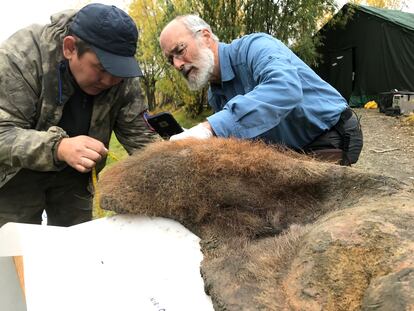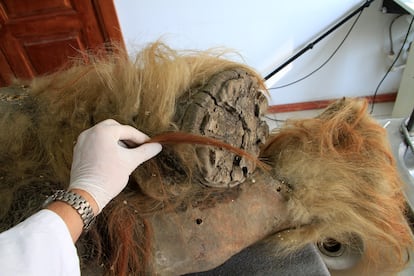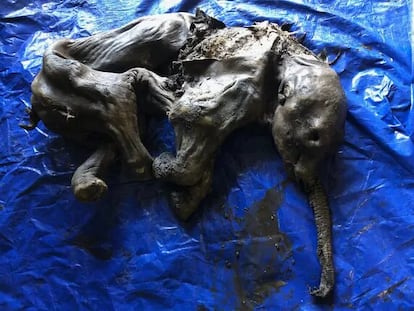Revolutionary technique reconstructs the 3D genome of the woolly mammoth, bringing de-extinction one step closer
The ‘chromosome fossils’ from a female who died 52,000 years ago in Siberia have opened a window to a world still unknown to science

For most people, traveling through Siberia in search of monstrous prehistoric creatures that have emerged from the depths thanks to melting ice would be considered an exceptional adventure. For Swedish explorer Love Dalén, that’s just a regular Monday. On September 3, 2018, near the remote Russian village of Belaya Gora, Dalén came across the remains of a female woolly mammoth, locked in the frozen ground for 52,000 years. Genetic analysis revealed on Thursday an extraordinary discovery: that mammoth corpse has preserved the 3D structure of its DNA, an unprecedented finding that even lets researchers know which genes were active. For scientists, these “fossils of ancient chromosomes” bring the possibility of resurrecting species that have been extinct for millennia one step closer.
“I have found many hundreds of mammoth specimens during my career, and this sample was extraordinarily well-preserved. It’s probably the best preserved mammoth sample I have ever come across in the field,” explains Dalén, a researcher at Stockholm University. “Seeing the well-preserved ear was an amazing experience that I will never forget,” recalls the scientist, great-grandson of Gustaf Dalén, who won the Nobel Prize in Physics in 1912 for inventing an automatic regulator that reduced gas consumption in the coastal lighthouses that guided the ships.
The new discovery is historic, but the fact that it was made in a mammoth is not the main issue, says geneticist Marc Martí Renom, one of the leaders of the research. The first time ancient DNA was recovered was in 1984, in the remains of a cuaga, a subspecies of zebra that became extinct in southern Africa a century earlier. Since that first cuaga, it has even been possible to obtain human DNA from hundreds of thousands of years ago, which has revealed lots of unexpected information, such as the fact the local men of the Iberian Peninsula disappeared about 4,000 years ago, or that modern humans and Neanderthals had children more than 100,000 years ago.
“People imagine the genome as a text, as if it were one letter after another. The reality is that the genome is a physical object that is two meters long, folded in the nucleus of the cell,” explains Martí Renom in a room at the National Center for Genomic Analysis (CNAG), in Barcelona. Until now, the ancient DNA fragments recovered used to have about 100 letters. The fossil chromosomes of the female mammoth have hundreds of millions of letters. Martí Renom compares his DNA to a puzzle with 3 billion pieces. Finding its 3D structure is like finding the photograph of the puzzle box.
Biologist Juan Antonio Rodríguez, co-author of the research, believes that this advance “can contribute to the de-extinction of species,” but calls for caution. “I wouldn’t like to see a zoo, a Pleistocene Park, where you can go see saber-toothed tigers, mammoths, woolly rhinos, cave lions or any type of extinct animal, because I think we would be bringing back to life animals that became extinct in circumstances that are not the same as those of now. We do not know how these species would react in current climatic conditions or to humans. Nor do we know if they would be genetically viable and could lead a normal life,” reflects Rodríguez, a professor at the University of Copenhagen, in Denmark. Some of the last mammoths lived about 4,000 years ago on Wrangel Island, north of Siberia, as published by the Love Dalén team a couple of weeks ago.

The U.S. company Colossal has announced that it aims to create mammoths in 2027, or rather elephants genetically edited to have the external features of a woolly mammoth. Three of the new study’s co-authors — Swedish explorer Love Dalén, English biologist Tom Gilbert and American geneticist Erez Aiden — are on Colossal’s scientific advisory board. The company received an injection of €70 million ($76 million) in 2022, from investors such as Thomas Tull, the producer of the film Jurassic World, and the famous millionaire Paris Hilton. Thomas Gilbert, from the University of Copenhagen, said in a statement that the new results “have obvious consequences for contemporary efforts aimed at woolly mammoth de-extinction.”
Erez Aiden is the father of Hi-C, a revolutionary method for studying the 3D architecture of DNA. Nearly a decade ago, his Mexican colleague Cynthia Pérez began to investigate whether this technique also worked with damaged DNA. “I started doing very modest experiments with my dinner, with the leftover chicken bones,” recalls Pérez, who also experimented with a roadkill mouse and the leather from her purse, in her laboratory at the Baylor School of Medicine, in Houston. When it was shown that the method also worked with damaged DNA, the team immediately contacted explorer Love Dalén, who in 2018, provided them with a sample of the female mammoth’s ear.
George Church, global genetics guru and co-founder of the company Colossal, believes that fossil chromosomes are a “powerful tool” for studying the history of life on Earth, but doubts that they will drive the resurrection of species. “The breakthrough needed for de-extinction is not 3D structure, but the ability to synthesize (or extensively edit) functional 3 billion basepair genomes. Currently, we can synthesize and precisely insert 4 to 12 million basepairs, and this is improving rapidly,” says Church, from Harvard University.

Marc Martí Renom and Juan Antonio Rodríguez remember perfectly the day they realized that the experiment with the mammoth had worked. It was March 11, 2020 and they were at the CNAG in Barcelona, with their Mexican colleague Marcela Sandoval, from the University of Copenhagen. They could even see that mammoths had 28 chromosomes, like elephants. “We can now understand the 3D structure and study the activation patterns of specific genes. This is a milestone in the field of paleogenomics,” says Sandoval. Two days later, the Spanish government decreed a state of alarm due to Covid-19 and issued a general lockdown.
It wasn’t just the pandemic that slowed down research. On February 24, 2022, Russia invaded Ukraine and sparked a war that continues today. Obtaining samples from other mammoths to repeat the experiments is even more difficult, but the authors succeeded with the remains of another female — possibly hunted by a saber-toothed tiger 39,000 years ago — found in 2010 in the Russian republic of Yakutia. The 3D structure of the chromosones shows that woolly mammoths had active genes linked to hair, cold and defenses against diseases.
The new study was published on Thursday on the cover of the journal Cell. Martí Renom, who also researches at the Barcelona Center for Genomic Regulation, compares the mammoth sample analyzed — freeze-dried 52,000 years ago — with jerky. The Houston team made a kind of beef jerky and tried damaging it. The scientists ran over the meat with a car, shot it with a shotgun, hit it with a hammer and put it in a microwave. Even a pitcher from the local Astros baseball team threw a ball at it at full speed. The jerky was destroyed, but the researchers were able to rescue its chromosomes intact.

The Hi-C technique applied to ancient DNA opens the door to a new world, according to Juan Antonio Rodríguez. “I think that obtaining fossil chromosomes from Neanderthals may be a little more difficult due to the state of conservation of the samples, but, for example, from Egyptian mummies it is possible. It is very likely that the fossil chromosomes are in that dried meat,” says the biologist. Seeing the 3D structure of a pharaoh’s DNA would allow researchers to see, for example, if he had active genes related to defenses against certain pests. Geneticist Marc Martí Renom believes that the corpse of Ötzi, a man murdered in the Alps 5,300 years ago and found in the ice in 1991, also “could be a good candidate” to apply the technique.
The new study includes a surprise finding: the authors estimate that the 3D structure of DNA could survive for 530 million years, given the right conditions. That has sparked fascinating theories. “Interestingly, a [DNA] sample might also travel quite far in that time. The only known interstellar comet, 2I/Borisov, is moving at roughly 32 kilometers per second. At this rate, it could reach Proxima Centauri, the closest star outside the solar system, in 40,000 years, less than the age of our woolly mammoth sample,” the researchers write.
Erez Aiden, the father of the Hi-C technique, recognizes the high margin of speculation, but defends his hypotheses. “We don’t know a lot of really basic stuff in this area. A lot of things are possible when you haven’t a clue how anything works. Before more modern telescopes and space probes gave people a pretty good look at the surface of Mars, a lot of pretty smart people thought there were canal-building Martians who lived there. This was less than a century ago,” says Aiden.
The authors believe that the DNA and proteins in the mammoth sample are in a glassy state, a substance they call chromoglass. “We pretty much don’t know anything empirical about whether DNA can survive in deep space, much less whether chromoglass, which, after all, comprises DNA and other molecules, can survive in deep space. It would be absolutely amazing and stunning if we looked on one of these comets and lo-and-behold we found DNA. I mean, that would be the big news. As a species, we are just very ignorant about a lot of things and this is one of them,” adds Aiden.
The Houston researcher answers questions from EL PAÍS while Hurricane Beryl wreaks havoc in his city and leaves his laboratory without electricity. Aiden wonders what evolutionary sense it makes for the DNA architecture of a mammoth to be preserved for 52,000 years. “Woolly mammoths are not plants that rely on making seeds that go into a sort of stasis only to be reanimated later. It just seems like the stuff of life, at its very core, is super durable, and it’s not totally obvious why it needs to be so darn durable. So there’s a mystery there,” he says.
Aiden mentions a hypothesis: panspermia, the theory that life travels through the universe on the backs of comets and asteroids. In that scenario, it would make sense for the genetic material to be as resistant as that of the mammoth DNA. The oldest DNA ever recovered comes from a two-million-year-old forest in northern Greenland. Erez Aiden also raises another, less compelling hypothesis. “It could just be dumb luck,” he says. “I’ve said it before: as a species, we are just very ignorant about a lot of things and this is one of them.”
Sign up for our weekly newsletter to get more English-language news coverage from EL PAÍS USA Edition
Tu suscripción se está usando en otro dispositivo
¿Quieres añadir otro usuario a tu suscripción?
Si continúas leyendo en este dispositivo, no se podrá leer en el otro.
FlechaTu suscripción se está usando en otro dispositivo y solo puedes acceder a EL PAÍS desde un dispositivo a la vez.
Si quieres compartir tu cuenta, cambia tu suscripción a la modalidad Premium, así podrás añadir otro usuario. Cada uno accederá con su propia cuenta de email, lo que os permitirá personalizar vuestra experiencia en EL PAÍS.
¿Tienes una suscripción de empresa? Accede aquí para contratar más cuentas.
En el caso de no saber quién está usando tu cuenta, te recomendamos cambiar tu contraseña aquí.
Si decides continuar compartiendo tu cuenta, este mensaje se mostrará en tu dispositivo y en el de la otra persona que está usando tu cuenta de forma indefinida, afectando a tu experiencia de lectura. Puedes consultar aquí los términos y condiciones de la suscripción digital.
More information
Archived In
Últimas noticias
Welcome to the post-religion era: The idea of Christianity as the absolute truth has become obsolete
‘I thought you would like it’: The risky sexual practice popularized by TV shows and TikTok
The digitalization of tourism: ‘They promise experiences and gave us the worst possible one’
Mexican peso defies uncertainty with forecasts of a new period of stability in 2026
Most viewed
- Sinaloa Cartel war is taking its toll on Los Chapitos
- Oona Chaplin: ‘I told James Cameron that I was living in a treehouse and starting a permaculture project with a friend’
- Reinhard Genzel, Nobel laureate in physics: ‘One-minute videos will never give you the truth’
- Why the price of coffee has skyrocketed: from Brazilian plantations to specialty coffee houses
- Silver prices are going crazy: This is what’s fueling the rally










































